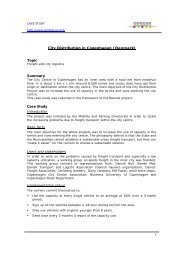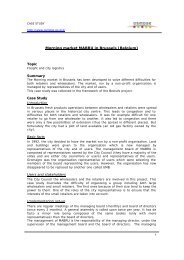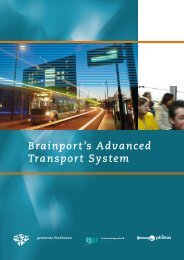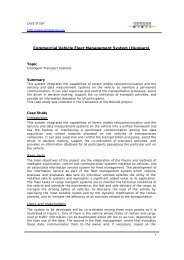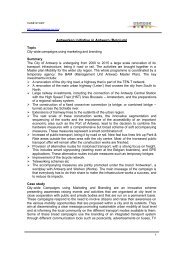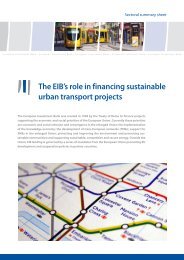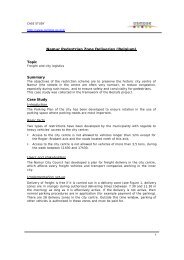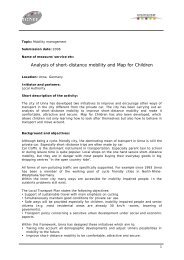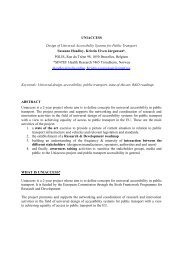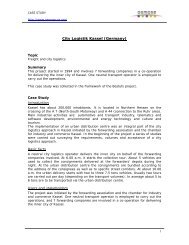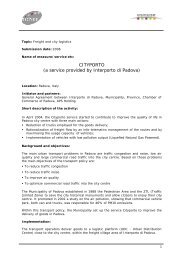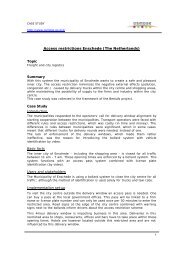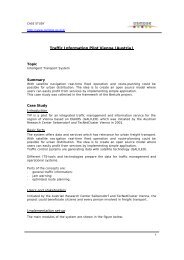Successful transport decision-making - Osmose
Successful transport decision-making - Osmose
Successful transport decision-making - Osmose
You also want an ePaper? Increase the reach of your titles
YUMPU automatically turns print PDFs into web optimized ePapers that Google loves.
Vol 2 - Table of Contents Next Practical information<br />
<br />
T1<br />
Designing the management of information<br />
Information management requires a customised strategy that has<br />
been developed by an experienced professional. The main tasks<br />
are similar for some projects:<br />
(1) Identification of information needs. Start with the output<br />
requirements: what regulations or legal requirements will<br />
apply to this <strong>transport</strong> project? If the project involves<br />
constructing infrastructure (a road, car park, tramline, etc.),<br />
are there any construction guidelines, issues relating to<br />
property rights, duties and time limits for providing<br />
information, holding hearings, responding to complaints,<br />
etc.? Review these various information needs systematically,<br />
and prepare a plan that identifies the kind of information<br />
separately. For example, information needed to meet legal<br />
requirements (planning information), and that required to<br />
measure the project's success (control information).<br />
(2) Prioritise these various information needs, by distinguishing<br />
'need to know' from 'nice to know'. More information does<br />
not necessarily lead to more successful project<br />
management. Sometimes information overload may provide<br />
a barrier to the <strong>decision</strong>-<strong>making</strong> process.<br />
(3) Gathering and processing of information. This includes the<br />
collection, collation and analysis of information, as well<br />
reporting in suitable formats. Consider using a mix of<br />
mediums and channels to circulate information: verbal<br />
communication, e-mail, letters, minutes, reports, folders,<br />
visual presentation, etc. Simplification is a great asset in<br />
information management.<br />
(4) Use of information: if the right questions have been asked at<br />
the start of the process, and the information management<br />
system has been well planned, then users will be provided<br />
with relevant information at the appropriate time.<br />
The following example is from a project in Graz, Austria, where a city-wide 30/50 kph scheme was introduced in 1992. It shows one part<br />
of the information management process, dealing with information flows associated with a campaign to support the scheme. This was a<br />
very important part of the project, since the innovative and restrictive nature of the scheme led to legal and technical uncertainties, which<br />
were exploited by those strongly opposed. The well-designed campaign contributed significantly to the success of the project, and now<br />
the scheme has gained general acceptance.<br />
Analyses Planning the campaign Executing the campaign<br />
Problem identification<br />
Demand for 30 kph zones<br />
Disadvantage of zonal model<br />
Advantage of city -wide scheme<br />
Technical analyses<br />
frequency/severity of accidents<br />
noise & exhaust emissions<br />
average speed on streets<br />
modal choice and route choice<br />
Social surveys<br />
attitudes towards the scheme<br />
estimation of impacts<br />
Conception<br />
objectives and basic strategy:<br />
1 st motivation, then information<br />
Content<br />
lines of argument<br />
messages to be delivered<br />
Target groups<br />
supporters/opponents<br />
residents/car drivers, etc.<br />
Detailed planning<br />
time schedule<br />
selection of instruments, etc.<br />
Motivation phase<br />
increase of problem awareness<br />
and increase of acceptance of<br />
the 30/50 kph scheme<br />
Information phase<br />
information of car drivers<br />
how regulation works<br />
and how to behave<br />
Aftercare operations<br />
reporting & publishing results<br />
of before-afterwards analyses<br />
Useful hints<br />
Establish a focal point for managing all key<br />
information flows. This may be an entire office (in the<br />
case of large projects), an information officer, or at<br />
the least, a nominated team member.<br />
Include objective data as far as possible in the<br />
<strong>decision</strong>-<strong>making</strong> process, as this is likely to maximise<br />
consensus. Information that is not trusted, or is seen<br />
to lack objectivity stimulates an emotional debate,<br />
aiding those who play on the fear of change (e.g. 'do<br />
nothing to be on the safe side').<br />
Adopt a proactive approach, by identifying the<br />
concerns of different stakeholder groups early on, so<br />
that information is available to address these<br />
concerns at the appropriate time.<br />
Opinions and attitudes are often changing, so ensure<br />
that information is regularly updated.<br />
Pay attention to the media. They can be effective in<br />
disseminating information, and may give unbalanced<br />
or inaccurate information if not fully briefed. (see T5:<br />
Media strategy).<br />
Changing information needs over time<br />
(1) Early stages: here the focus is on information<br />
gathering both in terms of project planning (e.g. legal<br />
and financial needs, property rights, etc.) and<br />
stakeholder engagement (understanding concerns,<br />
attitudes, etc.).<br />
(2) Middle stages: know the focus will change to a twoway<br />
communication: proposals, counter proposals,<br />
engagement, bargaining, negotiations, revisions, etc.<br />
(3) Late stages: After a <strong>decision</strong> has been taken it is<br />
important to inform people of the measure to be<br />
implemented, and to justify the <strong>decision</strong> to those who<br />
still disagree.<br />
What skills are required?<br />
Information management requires a range of<br />
technical skills including assessing information<br />
needs, data collection and data analysis, as well as<br />
the ability to devise and implement a strategy.<br />
Information management is also a creative job,<br />
involving communication and links between people.<br />
11



